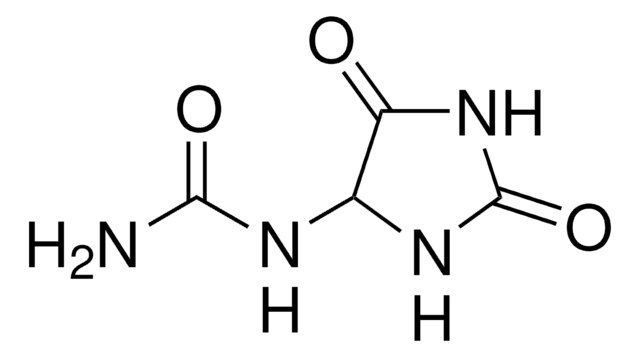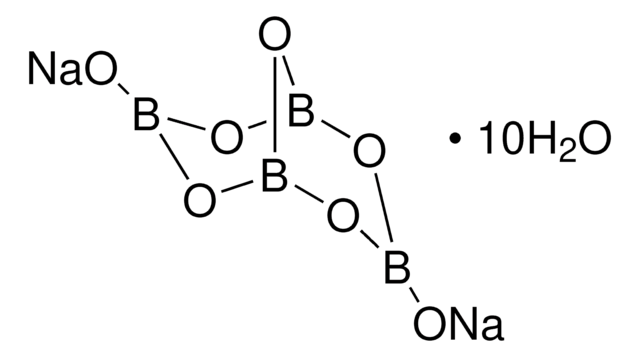B0394
Acide borique
ACS reagent, ≥99.5%
About This Item
Produits recommandés
Qualité
ACS reagent
Agence
suitable for SM 4500 - NH3
suitable for SM 5210
Pression de vapeur
2.6 mmHg ( 20 °C)
Essai
≥99.5%
Forme
powder
Technique(s)
PCR: suitable
Impuretés
≤0.005% Insoluble in methanol
≤0.05% Nonvolatile with methanol
Pf
160 °C (dec.) (lit.)
Solubilité
water: soluble
Densité
1.440 g/cm3
Traces d'anions
chloride (Cl-): ≤0.001%
phosphate (PO43-): ≤0.001%
sulfate (SO42-): ≤0.01%
Traces de cations
Ca: ≤0.005%
Fe: ≤0.001%
heavy metals: ≤0.001% (by ICP)
Chaîne SMILES
OB(O)O
InChI
1S/BH3O3/c2-1(3)4/h2-4H
Clé InChI
KGBXLFKZBHKPEV-UHFFFAOYSA-N
Vous recherchez des produits similaires ? Visite Guide de comparaison des produits
Description générale
Application
- N-substituted cinnamamides via amidation reaction between cinnamic acid and benzylamines.
- β-Aminoalcohols through the regioselective epoxides ring opening with aromatic amines in the presence of glycerol as a co-catalyst.
- Organosulfur compounds via thia-Michael addition of thiols to α, β-unsaturated compounds.
Mention d'avertissement
Danger
Mentions de danger
Conseils de prudence
Classification des risques
Repr. 1B
Code de la classe de stockage
6.1C - Combustible acute toxic Cat.3 / toxic compounds or compounds which causing chronic effects
Classe de danger pour l'eau (WGK)
WGK 1
Point d'éclair (°F)
Not applicable
Point d'éclair (°C)
Not applicable
Listes réglementaires
Les listes réglementaires sont principalement fournies pour les produits chimiques. Seules des informations limitées peuvent être fournies ici pour les produits non chimiques. L'absence d'indication signifie qu'aucun des composants n'est répertorié. Il incombe à l'utilisateur de s'assurer de l'utilisation sûre et légale du produit.
EU REACH SVHC Candidate List
EU REACH Annex XVII (Restriction List)
Faites votre choix parmi les versions les plus récentes :
Certificats d'analyse (COA)
Vous ne trouvez pas la bonne version ?
Si vous avez besoin d'une version particulière, vous pouvez rechercher un certificat spécifique par le numéro de lot.
Déjà en possession de ce produit ?
Retrouvez la documentation relative aux produits que vous avez récemment achetés dans la Bibliothèque de documents.
Les clients ont également consulté
Articles
Information on Isoelectric Focusing including what it is and how it is used. In order to ensure the high performance of analysis, isoelectric point (pI) standards are needed.
Notre équipe de scientifiques dispose d'une expérience dans tous les secteurs de la recherche, notamment en sciences de la vie, science des matériaux, synthèse chimique, chromatographie, analyse et dans de nombreux autres domaines..
Contacter notre Service technique







